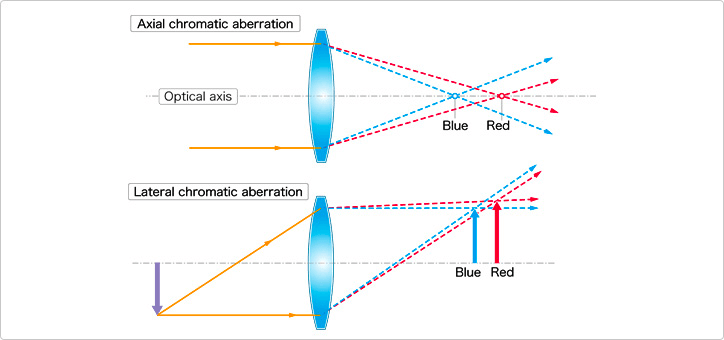Have you ever snapped a photo, been incredibly happy with the composition of it, the lighting! But suddenly you become overrun with dread to see red and blue color fringing around your subject? This, my friend, is chromatic aberration. In this article, we’ll take a look at the chromatic aberration definition as well as what causes chromatic aberration and how it can be avoided.
WHAT IS CHROMATIC ABERRATION IN CAMERAS?
First, let’s define chromatic aberration
There are two different types of chromatic aberration and simple ways to avoid both. But before we get into that, let’s get a solid understanding of the chromatic aberration definition.
CHROMATIC ABERRATION DEFINITION
What is chromatic aberration?
Chromatic aberration, often called “color fringing,” is a common optical color distortion that results in stray color along the outline of objects within a photograph. This aberration effect occurs due to a lens’ inability to focus the various wavelengths of white light onto the same focal plane. Because different wavelengths of light travel at different speeds, different colors can stray from a singular focal plane resulting in this chromatic aberration effect. Different colors appear depending on the type of aberration that occurs.
Ways to avoid chromatic aberration:
- Use a high-quality lens
- Avoid wide-angle lenses
- Shoot at a narrower aperture
WHY DOES IT HAPPEN?
What causes chromatic aberration?
To understand how to avoid this effect, it’s first important to understand how and why it occurs. What is chromatic aberration caused by? First, we need to review the properties of light and how it travels.
White light contains all wavelengths of color. However, various wavelengths (and various colors) travel at different speeds.
The speed differences of these different wavelengths change how each passes through a lens’ elements. The refractive index of the glass within a lens can cause these wavelengths to land on different focal points as they pass through.
Here’s an explanation courtesy of Pixel Prophecy.
This phenomenon is influenced by various factors such as quality of lens, aperture, quality of light, etc. The result is a fringe of color on the edges of objects within your photograph.
WHAT IS CHROMATIC ABERRATION IN CAMERAS?
Types of chromatic aberration
What does chromatic aberration do to photos? It depends on what type of aberration occurs. There are two specific ways light can lead to chromatic aberration in photography and cinematography.
Lateral aberration
Lateral aberration occurs when there is a variation in the level of magnification of different wavelengths of light. Also called transverse aberration, this type of aberration leads to blue-yellow or red-green color fringing.
Axial aberration
Axial aberration occurs when there is a variation in the speed and length of a wavelength of light resulting in a failure of these wavelengths to land on the same focal plane.

Chromatic aberration is common and sometimes used as a stylistic choice. However, if you want to capture images as true to life and reality as possible, it’s important to do what you can to avoid it.
SOLUTIONS
Fixing chromatic aberration
While it is possible to address and minimize aberration in post-production, avoiding it all together while shooting will lead to the most true to life photographs. Here are a few tips to avoid this effect.
Use a high-quality lens
Using a high-quality lens will decrease the opportunity for aberration to occur because of the higher quality glass elements within your lens. These lenses will properly refract light and minimize aberration as light passes through.
Shoot at a narrower aperture
Finally, when possible shoot at a narrower aperture. Why? When shooting wide open, say at f/1.8, the amount of light entering the lens increases and increases the chances of seeing aberration in your images. New to the concept of camera aperture? Check out our full video breakdown of aperture below.
If you’re short in light, utilize a higher ISO, flash, or slower shutter speed to close down your aperture.
Avoid using wide-angle lenses
Wide-angle lenses are great tools for capturing landscapes, unique portraits, and much more. However, because these wide focal lengths are the extremities of the glass within a lens, they open the door for chromatin aberration to occur. Take a look at this visually in the aberration example below.

If you are really trying to avoid this type of aberration in your photography, avoid using wide-angle lenses or at the very least, invest in a high quality wide-angle lens.





